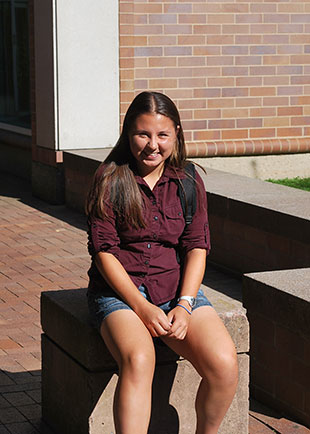Cornell Perspectives: A high schooler’s taste of an Ivy lab
By Deanna Deyhim

This past summer I worked in one of Cornell’s cell and molecular biology labs, and although current students at Cornell have access to these resources on a day-to-day basis, having the chance to work with top-end equipment for an Ithaca High School student was an amazing experience.
When I started working in professor of cell biology William J. Brown’s lab, I learned the fundamentals of how to use basic equipment, such as a pipette along with a pipette aid. Of course, the first time I used the pipette aid by myself I accidently clogged the filter, which is basically the only way to make it stop working. Fortunately, Danielle Kalkofen, a graduate student working in the lab, came by and helped me replace the filter.
After becoming comfortable transferring liquids from dishes to culture plates to flasks, I moved on to growing cells in culture. In my AP Biology class last year, I was assigned “The Immortal Life of Henrietta Lacks,” and so when I found out that the cells I would be growing were from Lacks’ cell line, it felt amazing to have what I was reading and learning about be put into practical application.
Besides Danielle, two undergraduate students were working in Professor Brown’s lab, Angelina Noriega and Ruchika Podury I watched them doing some of their experiments to get a better understanding of using the lab’s microscopes and other instruments. It was incredible getting to work with such intelligent and admirable people. Both women always gave me a chance to try parts of the procedure myself when we were working together, and working with women not much older than I made the work more enjoyable.
One experiment I performed in the lab was testing whether cytochalasin D, which disrupts actin microfilaments in cells, causes any differences in the morphology of the Golgi complex. I tested multiple timed exposures of my cell culture to the cytochalasin D and viewed the results on a confocal microscope. Never having used such a high-caliber microscope, I saw for the first time that cells don’t look like what they show in textbooks but can actually look like disfigured blobs. Of course that might have just been because I had squished my cells a bit too much when plating them so they came out looking like squiggly jellyfish.
When Angelina and I were working together, I asked her how she came to work with Professor Brown over the summer. She told me he was one of the few professors who had gotten back to her with a positive response about working in his lab. I told her it was the same for me, and we agreed that we were very fortunate to work in his lab. He was always willing to help me, and his friendly demeanor made him easy to approach and talk to. He took the time to teach me material I was not familiar with, and his flexibility and easy-going nature made him a professor second to none.
I contacted Professor Brown initially because I am interested majoring in bioengineering and wanted to learn more about what I would be studying and if it was really for me. After working in this lab, I am confident in my decision to major in bioengineering, and I am extremely fortunate to have had the chance to work with such amazing people in a Cornell lab.
Deanna Deyhim is a senior at Ithaca High School.
Media Contact
Get Cornell news delivered right to your inbox.
Subscribe